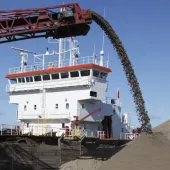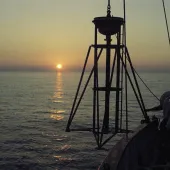Latest marine aggregates ‘Area Involved’ data released

BMAPA and The Crown Estate publish their nineteenth annual ‘Area Involved’ report
THE British Marine Aggregate Producers Association (BMAPA) and The Crown Estate have published their 19th annual ‘Area Involved’ report, which details changes in the extent of the seabed area licensed and dredged for marine aggregates during 2016.
The ‘Area Involved’ initiative commenced in March 1999, when BMAPA and The Crown Estate made a public statement of intent which committed both parties to reviewing all dredging licences on a rolling five-year basis, surrendering areas no longer containing economic resources of marine sand and gravel, and publishing an annual report detailing the extent of dredging activities within licensed areas.
BMAPA director Mark Russell said: ‘The area of seabed licensed and dredged remain key indicators of the UK marine aggregate sector’s performance and its potential to interact with both the environment and other marine users. The significant reductions in both indicators that have taken place over the last 19 years demonstrate an industry committed to continual improvement.’
Nick Everington, marine minerals portfolio manager for The Crown Estate, said: ‘As manager of the seabed around England, Wales and Northern Ireland, we work in partnership with industry, to help support the sustainable use of sand and gravel resources. The annual ‘Area Involved’ report is an integral part of this, helping to ensure our better understanding and management of the marine environment over the long term.’
Key information from the report includes:
- A total of 17.94 million tonnes of sand and gravel were dredged from Crown Estate licences in England and Wales during 2016 (18.82 million tonnes in 2015)
- The total area of seabed licensed in 2016 was 934km sq (932km sq in 2015)
- Dredging took place within 87.53km sq, 9.37% of the licensed area, compared with 82.67km sq (8.87%) in 2015
- The area of seabed dredged for more than 1 hour 15 minutes per year (high intensity – red on charts) was 7.52km sq (7.37km sq in 2015)
- 90% of dredging from Crown Estate licences took place from an area of 33.92km sq (31.58km sq in 2015).
With the continued development and evolution of marine planning, high-quality spatial and temporal data relating to marine aggregate dredging activity makes an important contribution in supporting the sustainable management of UK waters, and both BMAPA and The Crown Estate remain committed to maintaining and developing the Area Involved reporting initiative.
Marine aggregates meet more than 20% of the sand and gravel demand in England and Wales, with the majority of supply used in high-value ready-mixed concrete and concrete products.
Certain regions are particularly reliant upon marine supplies. For example, one third of all primary aggregate demand in London and the South East is met from marine resources, whilst in South Wales more than 90% of the market demand for sand is also met from the sea.
A downloadable copy of the 19th annual ‘Area Involved’ report is attached below.









